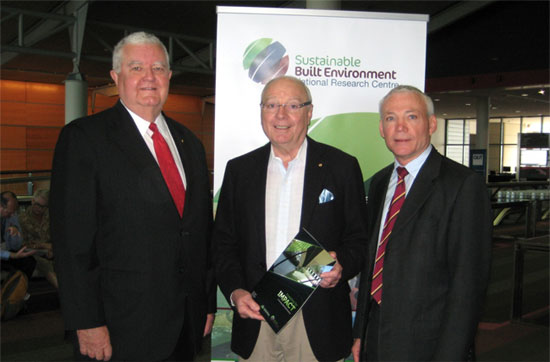Dear Colleagues
Our big news is the completion of the highly successful CIB World Building Congress held in Brisbane last month. The Congress was jointly hosted by SBEnrc and QUT, and showcased some of the world’s best research and development in the built environment sector by the global CIB research network. More than 460 researchers presented peer reviewed papers and contributed to discussions about the relevance of construction research to society.

This congress was a wonderful opportunity for the SBEnrc research team to showcase the work we are doing on the world stage, as we presented the outcomes of Phase 1 (2010-12) of our Centre.

Dr Keith Hampson CEO, SBEnrc and John V. McCarthy AO Chair, SBEnrc
A highlight for us was the launch of our latest publication, Investing for Impact. We were honoured to have Professor Ian Chubb, Australia’s Chief Scientist, take time from his busy schedule to launch this for us.

Investing for Impact summarises research findings and case studies from fourteen countries, (Australia, Brazil, Canada, Denmark, Finland, France, Germany, Hong Kong (China), India, New Zealand, Norway, Sweden, the Netherlands, and USA), highlighting various national research programs and their community impact. This industry-focused booklet is the prelude to a more complete book with detailed case studies and analysis of R&D strategies and outcomes to be released in 2014.
The outcomes of this project will help investors better match funding strategies to industry needs for a stronger and more productive built environment industry.
Investing for Impact can be downloaded free of charge from the SBEnrc.
Other highlights were the keynote addresses by our international colleagues Professor Martin Fischer of Stanford University and Brian Krause from Turner Construction Company. Professor Fischer highlighted the opportunities for BIM research into practice and Brian Krause provided hard core evidence of the business benefits of BIM. Summary versions of their presentations are available at www.sbenrc.com.au.
The Congress also signified the end of John McCarthy’s three year term as global Presidency of the CIB. However he will continue to serve on the CIB Board, as well as continue to serve as Chair of our national SBEnrc Board.
An update from the SBEnrc Board
I’m pleased to announce that the SBEnrc Board has approved two new applied research projects, to be led by QUT and Curtin University:
1. Building Information Modelling (BIM) for Smarter and Safer Scaffolding Construction
Temporary structures like scaffolding have a significant impact on the quality, safety and profitability of construction projects. Workplace Health and Safety (WHS) Authorities in Australia have found that 40% of all scaffolding projects do not comply with national safety and design standards. This research will facilitate the design and construction of smarter and safer scaffolding through the use of rule-based computer modelling systems that link with existing BIM software and technology. It will develop digital modelling tools and processes that integrate construction and safety constraints directly into the design, analysis, assembly, inspection and disassembly of these temporary structures. Building on a pilot study, completed at QUT in 2012, this project will identify opportunities for improved safety practices and more efficient design and construction processes, both in Australia and Korea, and seeking to extend to other parts of Australasia.
2. National BIM guidelines and case studies for infrastructure
Mechanisms that improve collaboration and communication in the construction process are becoming ever more critical in the quest for increased productivity. The CRC for Construction Innovation (the predecessor of the SBEnrc) released the National Guidelines for Digital Modelling (Commercial Buildings) in 2009 which demonstrated how open and consistent processes allow practitioners to better work together in developing shared virtual building projects. A set of case studies demonstrating the business impact of BIM in building was also published, outlining the lessons learned. There is an identified industry need for guidelines and case studies to be developed for the infrastructure sector – in a complimentary mode to resource and mining developments in this area. With strong input from WA, Queensland, NSW and Victoria, this project will leverage off the earlier formative CRC for Construction Innovation and successes in positioning BIM as a key productivity driver for commercial buildings.
Best regards
Keith

